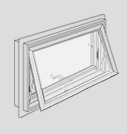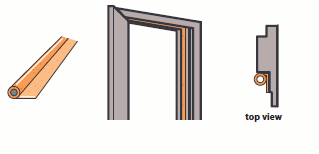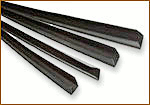casement windows and their weatherstripping
Casement windows are the best to prevent air leakage.
Possible weatherstripping problems are also easy to fix. You just have to choose the right weatherstripping and press it into the outside of the stops. Casement windows are also excellent for natural ventilation strategies.
Casement, awning and hopper windows share the same window frame design, based on hinges and compression seals.
 advantages
advantages
The operation system of casement windows – the window sash presses against the frame when the windows is closed – creates an airtight seal that minimizes air leakage.
Casement windows provide a wide opening, and can open outward and be angled in or order to direct breezes into the house, when they blow in unfavorable directions - an important feature for natural ventilation strategies.
See: Breezes and Natural Ventilation.
The type of windows makes a big difference for energy savings. But do not overestimate it.
There are other factors that are equally important, for energy efficiency:
-
the materials used in the frames of the windows (aluminum is too heat conductive) and
-
the number of panes and details involving the glazing.
Possible Disadvantages
Because of their design they can’t be too large or too heavy; larger windows require a strong enough support system.
Awning windows 
Awning windows are hinged at the top and swing outward instead of being hinged at the side, like the casement windows.
They share most of the pros and cons of casement windows, but they do not provide their ventilation capability.
Their design makes opening and closing less easy.
Hopper windows
A hopper window is an inverted awning window, opening inwards… with the sash hinged at the bottom.
Hopper windows are common in basements and share the same pros and cons of awning windows. They can be less easy to open and close, and to clean.
Weatherstripping materials for casement windows
 Adhesive backed tape - made from foam or sponge rubber - comes with various widths and thicknesses. It's self-adhesive, easy to install and inexpensive. Adhesive backed tape wears quickly, and you may have to install it every few years.
Adhesive backed tape - made from foam or sponge rubber - comes with various widths and thicknesses. It's self-adhesive, easy to install and inexpensive. Adhesive backed tape wears quickly, and you may have to install it every few years.
Reinforced felt and special gaskets (in the form of tubular vinyl, silicone or sponge-rubber tubes) are good alternatives. Gaskets will last longer - at least 5 years -, while tapes and felts may last just 1 or 2 years.
Installation issies
Before applying any self-adhesive material, clean (with water and detergent) the surface where the weatherstripping is going to be applied.
Do not apply the weatherstripping material over dirty (oily, dusty, greasy, damp..) or wet surfaces.
Cleaning the residues of paint may require proper solvents. If there is residues of previous adhesive weatherstripping, remove them with petroleum jelly.
Wait for a sufficiently warm day to apply the adhesive materials. Installing adhesive foams require temperatures of at least 50º-60º F (10-15º C) for a good bond.
Applying adhesive backed tape 
Use the adhesive tape on the four sides of the stops.
Apply carefully the adhesive along the stops of the window, while removing its backing. Follow the manufacturer's instructions.
To make a tight bond (after laying the weatherstripping) apply pressure all over the adhesive. Use your fingers...
Applying Windows Weatherstripping felt
Use the felt on the four sides of the window stops. Follow the procedures mentioned to the adhesive tapes.
Just cut to length and staple or tack the material into place.
Applying Weatherstripping gaskets (Tubes of sponge rubber, vinyl and Silicone)
Use the gaskets on the four sides of the casement window stops. ![]()
Weatherstripping gaskets are more expensive but they provide a tighter seal and will last longer than rubber and adhesive felts and tapes.
The gasket tubes come with a flange that should be stapled over the stops of the window. Follow the package instructions.
See also:
Residential window prices and paybacks
The best windows for cold, mixed and hot climates
Window films for energy savings
Sliding Windows Energy Efficiency
Weather-stripping your windows
Window weatherstrip materials
Aluminum vs Vinyl vs Fiberglass vs Wood vs Clad window Frames and Sashes
Window sizing and placement
Top Double and Triple Pane Window Manufacturers
![]() Related Content
Related Content
![]() Top .... Home Page
Top .... Home Page


